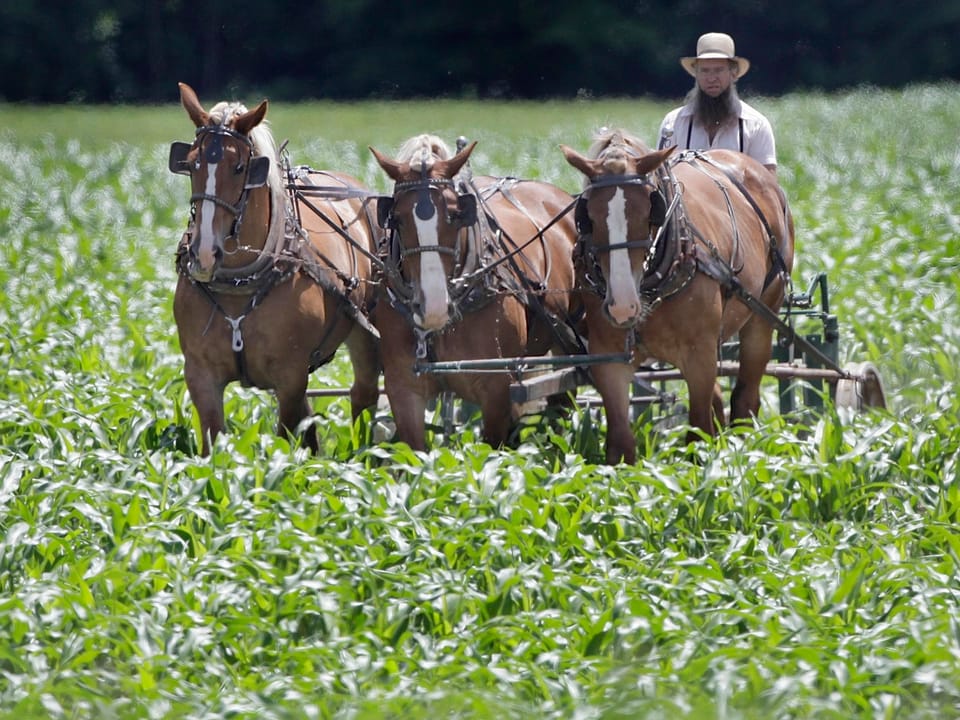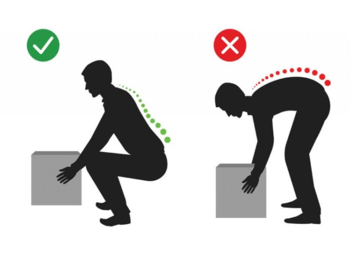The Amish Fitness Plan.

When my friend Tristan recently spent a week on the outskirts of Harrisonburg, VA, he encountered a very normal suburban tableau on his cycling route. School had just let out and the area was swarming with kids.
However, there was one thing strikingly different on this particular day: there were no cars. Scores of kids were walking or cycling home, and their parents were nowhere to be seen. In a society hyper vigilant about safety, this was anachronistic. So too, was the modest attire and the occasional horse and buggy.
Tristan said he felt like he was “stepping back in time.” And, in some ways, he was. He was in Mennonite Country.
There were other telltale signs. All the food was fresh and organic. The air was devoid of pollution, save for the scents of freshly baled hay and animal dung.
Both Tristan and a friend were cycling up a formidable peak called Reddish Knob, which has sweeping views over the Shenandoah Valley. They were riding modern ultra lightweight carbon bikes, attired in fancy kit, and had their "Strava" apps turned on.
"Everything was 'pro' except the riders" recalled Tristan with a chuckle. They were also joined by a third rider, who was a local. He was wearing dungarees, boots, and rode a heavy metal "beater" bike with a limited amount of gearing.
"I wouldn't have the capacity to take that bike up that climb," said Tristan. The local rider regaled them with stories and gave them insight into the farmland's history. It wasn't surprising that the man was a repository of local lore — he was in his eighties.
Looking back on the trip, Tristan recalled that perhaps the most startling element was what wasn't there. In a country where 42 percent of the population is obese, there weren't any people that Tristan saw that were noticeably out of shape or overweight.
But perhaps Tristan shouldn’t have been surprised. The Mennonite community is closely linked to the Amish community. They descended from the same area in Switzerland. They both adhere to modest dress codes and eschew many modern forms of technology. (The Mennonites are more lenient in this regard. Some own cars, telephones, and televisions. The Amish strictly forbid these things.)
The cuisine also has a lot of overlap, including full fat breads, pies, and meats. A few of the staples include the "whoopie pie" ( a sandwich cookie made with soft cake rounds and creamy filling), "shoofly pie," ( a pie filled with local molasses) and Pennsylvania Dutch Potato Doughnuts (pretty self-explanatory.)
And yet, according to one famous study, the Amish are among the fittest people in the country. Given the fact that they consume large quantities of calorie-laden food, how is this possible? The answer is simple. They move. All day long.
The study, conducted by researchers from the University of Tennessee, attached pedometers to one hundred Amish adults in Ontario, Canada (which the Amish community insisted on returning in accordance with their religious practice.) The lead scientists were intrigued by the amount of physical activity the community did on a daily basis, including tilling soil, plowing fields, chopping wood, building barns, gardening, and hand washing laundry. This was also measured against the extremely calorie-rich food the Amish community consumed. (1)
The results were astonishing. The Amish men averaged 18,000 steps a day and the Amish women averaged 14,000 steps a day. These numbers far exceed the recommended 10,000 steps a day put forth by the Center for Disease Control. There was an even starker contrast in the amount of moderate to vigorous physical activity (MVPA). The World Health Organization recommends 2.5 hours of MVPA at the upper end. Amish men averaged 43 hours of moderate activity a week, women about 39 hours. For non math-majors (myself) that equates to seventeen times the recommended amount of activity.
Lastly, the number of Amish men who were considered obese by BMI standards (>30) was zero, and the number of women considered obese was nine percent. Given the number of famous desserts in Amish culture, this was a shocking finding. But the researchers clearly had an inkling that some of the results were pre-ordained.
“The Amish were able to show us just how far we’ve fallen in the last 150 years or so in terms of the amount of physical activity we typically perform,” said lead researcher David R. Bassett, a professor at the University of Tennessee, Knoxville. “Their lifestyle indicates that physical activity played a critical role in keeping our ancestors fit and healthy.
"(The study) can provide a sense of what we ought to be doing," he continued. "It's a little ridiculous – we drive to work, then go to the gym to walk on a treadmill. We go to great lengths to remove activity from our daily lives, and then we go to great lengths to put it back in. The Amish have done a better job than anybody of consciously thinking what impact technology will have on their lives." (2)
So, given the fact that very, very few of us live on farms, what can we do? Perhaps a savvy entrepreneur will find a way to monetize "Amish fitness," and start a gym, complete with tractor-pulling machines, cow-milking stations, and "authentically soiled" dungarees. Until that time, here are a few suggestions:
(1) Focus on "frequency" of movement rather than "intensity". This may seem counterintuitive when "HIIT Training" is all the rage. But unless you have a very good fitness base already, moving gradually throughout the day is going to make more sense. The Amish people cited in the study didn't do burpees or jumping jacks to stay in shape. They just moved constantly.
I've written about "NEAT" (nonexercise activity thermogenesis) before. (3) Essentially, this involves the amount of calories you're burning due to everyday activity. For the Amish, that's a lot. Some practical solutions for city and suburban dwellers include taking the stairs more frequently, parking the car further away, or getting a standing desk.
(2) Lift heavy objects occasionally. I'm a huge proponent of bodyweight exercises, and many of my articles focus on them. They're safe, effective, and you can do them anywhere. So this suggestion may seem a bit incongruous. But there's little doubt that lifting heavy objects result in fitness gains — provided that you have the physical strength to do it and use good form. Those are important caveats.
Lifting heavy objects (such as free weights, potted plants, sand bags, etc) develop bone density and help mitigate muscle loss (sarcopenia) that's a natural by-product of aging. Lifting heavy objects also strengthens the connective tissues that provide structural support, making you less likely to strain or tear a ligament. Additionally, the movement helps strengthen your lumbar complex (lower back), ab complex, and glutes.
But, in order to successfully lift heavy objects, you can't go from "zero to sixty." If you can't execute basic exercises (such as a series of pushups) you're better off starting with a bodyweight regimen and progressing from there. And good form is crucial. In order to "squat and lift," you should ensure you're hinging at the hips, engaging your core, and driving your hips back as you lift. Keep your feet wide for a solid base of support, and DON'T USE YOUR BACK in lieu of your lower body when you lift. Here's a helpful do/don't illustration:

(3) Get a Fit-Bit. Whenever I'm at a random social gathering, and people learn I'm a personal trainer, I inevitably get the question: "what can I do to get in shape?" A closely related question is what exercise(s) they should be doing. The reality is, of course, that there's no magic bullet or quick fix to fitness. The program or regimen that works the best is that one that you'll do frequently and safely.
But, if I'm really pressed by someone desperate for fitness advice, I'll often tell them to get a Fit-Bit or some other similar movement tracker. The answer can come across as snarky. But it's the truth. At the end of the day (I just love that expression) what matters most is how often you've moved. That's what the pedometer was utilized for in the Amish study. They didn't break it down into sub-categories such as "plowing," "tilling," "milking the cows," and "sawing lumber."
Just focus on sitting less, and you'll be a lot healthier and fitter. You might even be able to eat a hearty slice of shoofly pie. Guilt free.
Sources:
(1) David R Bassett et al. (01/2004) "Physical Activity in an Old Order Amish Community." Medicine & Science in Sports & Exercise
(2) Jeannine Stein (01/12/2004) "The Amish Paradox." The Los Angeles Times
(3) https://beneath-the-skin.ghost.io/n-e-a-t-2/
Joshua Brandt is an Oakland based personal trainer. He can be reached at joshua@joshuabrandtpt.com or (415) 412-7339.
If you enjoyed reading this article, please pass it along!
Member discussion